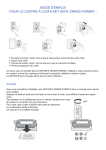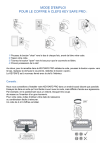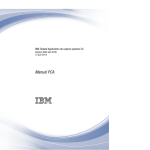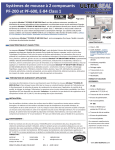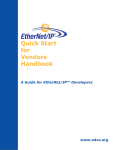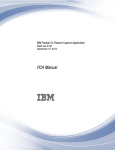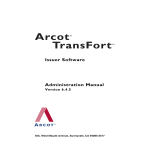Download UEFI Summer Plugfest 2011
Transcript
presented by Building Secure Firmware with HardwareSecurityModules(HSM) UEFI Summerfest – July 15-19, 2013 Presented by Vishal manan (Microsoft Inc.) Updated 2011-06-01 UEFI Summerfest – July 2013 www.uefi.org 1 Agenda • • • • PKI for Secure Boot HSM overview KPI’s for HSM Key Generation using HSM • Good practices for HSM usage • Questions UEFI Summerfest – July 2013 www.uefi.org 2 Stolen Private keys Blackbaud Trojan Stuxnet Zeus banking Trojan UEFI Plugfest – February 2012 … Mediyes Trojan www.uefi.org 3 Secure Boot relies on PKI Key/db Name Variable Owner Details PKpub PK OEM PK – 1 only. Must be RSA 2048 or stronger Microsoft KEK CA KEK Microsoft Allows updates to db and dbx. Microsoft Windows Production CA db Microsoft This CA in the Signature Database (db) allows Windows8/Windows Server 2012 to boot Forbidden Signature Database dbx Microsoft List of known bad Keys, CAs or images from Microsoft + Required for Secure Firmware Updates (not mandated by UEFI but by NIST 800-147) Key/db Name Owner Details Secure firmware update key OEM Recommendation is to have this key be different from PK. Must be RSA 2048 or stronger + any other (proprietary) keys HSM Basics –Hardware device to generate and protect crypto keys • The private key never leaves the HSM –Either stored on the HSM or –Encrypted on the HSM –Role based two factor authentication –Supports M of N authentication –Compliance with FIPS 140-2 level 2/3/4 • Tamper evident or tamper resistant –In the world of security every bit counts!! HSM Device Overview 3 main components* 1. PCI/USB or Network card – – Has a switch to change mode • I – Init • O – Operation • M – Maintenance 2. Smart Card reader/PED based 3. Smart Cards or USB authentication tokens *We show the Thales HSM as an Example Secure Boot Without HSM – Bad News… Partners/OEMs Partner has 1 Key for all the Locks on a server Steals Platform Key or Secure Firmware update Key Secure Boot protection Secure Boot key management with HSM Partners/OEMs Partner has 1 Key for all the Locks on a HSM Store Platform key in HSM HSM Key vault Secure Boot protection Using HSM for Generating Certificates • Leverage inbox certutil.exe • Certificate attributes: • Key algorithm – RSA-2048 • Hash algorithm – SHA-256 • Self-signed certificate or derive it off an enterprise CA if you have one • Decide on the validity period for the certificate • Pick HSM CNG as the CryptographicServiceProvider • Need a CSP which can do Microsoft CNG to support SHA256 hashing algorithm • Back up the certificate As good practice please always backup the certificate you generated. HSM usage KPI’s • Creates a Security framework and hence Lowers chances of Private Key leak • Lower support costs • Can store keys on the HSM and back it up • • HSM not as susceptible to data loss as a server Network HSM can allow for High Availability (HA) • Key deletion and changes require at least n of m people to be present • Protects against industrial and political espionage • Can be used for creating CA’ s HSM for key generation UEFI Summerfest – July 2013 www.uefi.org 11 Certificate creation using HSM Create certificate certreq.exe -new request.inf PK.cer Sample request.inf file may look like: [Version] Signature= "$Windows NT$" [NewRequest] ValidityPeriod = Years ValidityPeriodUnits = 6 Subject = "CN=Corporation TODO Platform Key,O=TODO Corporation,L=TODO_City,S=TODO_State,C=TODO_Country" MachineKeySet = true RequestType=Cert Exportable = FALSE HashAlgorithm = SHA256 KeyAlgorithm = RSA KeyLength = 2048 KeyContainer = "PKContainer" ProviderName = "nCipher Security World Key Storage Provider" KeyUsage = 0xf0 Key generation using HSM(contd.) Validate the certificate certutil –store –v my "7569d364a2e77b814274c81ae6360ffe“//CERT. Serial # my ================ Certificate 16 ================ X509 Certificate: Version: 3 Serial Number: 7569d364a2e77b814274c81ae6360ffe Signing with HSM(contd.) Available with the Windows SDK and used for signing binaries Command signtool.exe sign /v /fd sha256 /sha1 "db314da0d0ef87d42b42f74b9c38a1f9173ef7 a2" /sm /p7 .\ /p7co 1.2.840.113549.1.7.1 /p7ce DetachedSignedData <binarytosign>.bin Paramaters specific to generating certificates with HSM /sm – use local certificate store /sha1 – Hash of the certificate Managing keys – using HSM vendor tools Good practices for HSM usage Read the Whitepaper on Security planning http://technet.microsoft.com/en-us/library/cc723503.aspx Read the HSM vendors User manual Decide on Security roles Operational Staff Security Policies Security Officers Access Control Rules Transaction Authorizer Risk Control Strategies Key Management Operational Procedures IT Administrator 7X24 Availability Factory floor lead Contingency plan Outsourcing Agent (ISP) Disaster Recovery Chose FIPS 140-2 level 3 Pick n and m >1 for n of M authentication Good practices for HSM usage (contd.) Have an AdministerCardSet for the HSM and an OperatorCardSet for Secure Boot Use an HSM CSP which supports SHA 256 and Microsoft CNG API such as "nCipher Security World Key Storage Provider“ Generate Certificate for PK, Secure Firmware update key and optionally other components such as OEM KEK Self Signed or derived from a CA Uses RSA 2048 as encryption algorithm SHA 256 as hash algorithm Decide on validity period Backup the certificate Label the certificate with the model # of the machine Generate new certificates at a regular cadence Good practices for HSM usage (contd.) Setup and use HSM vendor GUI (KeySafe) utility for better key management Test generation of certificates in a production environment Test sign sample PK.bin/KEK.bin with the private key stored in the HSM and use the HSM as CSP Backup the HSM metadata(Security world/partitions…) on multiple sets of media periodically Try Restoring a deleted key using backup data Make sure Disaster recovery works Thanks for attending the UEFI Summerfest 2013 For more information on the Unified EFI Forum and UEFI Specifications, visit http://www.uefi.org presented by UEFI Summerfest – July 2013 www.uefi.org 19





















